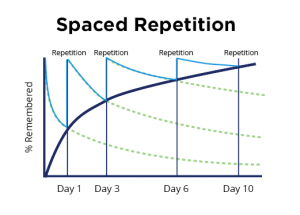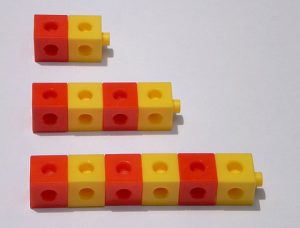Most school systems teach in blocks. Peak into any school, and you’ll see that they are teaching one topic. It usually goes introduction, explanation, practice, revise, and then finally a testing for mastery. Rinse, repeat ad nauseam. You likely know this as most people teach in this method because that’s how they were taught. It’s the concept of attempting to master one specific skill or topic in a subject before moving onto the next.
We all know how well this works. Eventually, it does. For some people it works really well. Others… not so much. So let me introduce you to the learning method called “interleaving.” You may find that it opens up a whole new world for you and those that you pass knowledge onto.
Interleaving Learning 101
 Interleaving is often used in conjunction with a concept of spacing. Spacing was used as early as 1885 when Herman Ebbinghaus discussed the usefulness of spacing (or pacing) while learning a topic. Ebbinhaus noted that learning a block of information and reviewing it back to back, while can teach quickly, the retention of information is very poor(Ebbinghaus, 1885). We all have real life examples of this with the phrase “cramming” as we study for a presentation with a client or study at the last minute for an exam. We’ll remember the info for a short time, but it’s unlikely we’ll remember it just a day or two later.
Interleaving is often used in conjunction with a concept of spacing. Spacing was used as early as 1885 when Herman Ebbinghaus discussed the usefulness of spacing (or pacing) while learning a topic. Ebbinhaus noted that learning a block of information and reviewing it back to back, while can teach quickly, the retention of information is very poor(Ebbinghaus, 1885). We all have real life examples of this with the phrase “cramming” as we study for a presentation with a client or study at the last minute for an exam. We’ll remember the info for a short time, but it’s unlikely we’ll remember it just a day or two later.
The spacing effect is when you topic of study is spaced out over a longer period of time. As you can see from the graph above, the first day the recall is terrible. You just learnt the information, so that’s no surprise. The second day of repetition you remember a little more. From life experience we know that the more we repeat something, the more natural it becomes and instantaneous the recall is. Sure, it’s a slower method of learning, but the potential for recall is greater over time. If you pair this with the concept of interleaving, it can be quite powerful.
Interleaving is taking the space between learning the topic and reviewing the topic to “seat” it in some other topic (“Everything You Thought You Knew About Learning Is Wrong,” 2012). Take a look at the Legos below. The whole stick represents one topic. The orange colour represents the new topic you are trying to learn, and the yellow represents the concepts you already know or skills that are very closely related. In the shortest stick, you alternate between two mini-skills. In the larger ones, you can alternate between the new skill and many previous skills you know.
 For example, if you are trying to learn kung fu (and who doesn’t want to be Bruce Lee?), you’d shuffle between footwork, punches, kicks, and posture — all very closely related skills. You wouldn’t go from footwork to accounting, to studying European capitals.
For example, if you are trying to learn kung fu (and who doesn’t want to be Bruce Lee?), you’d shuffle between footwork, punches, kicks, and posture — all very closely related skills. You wouldn’t go from footwork to accounting, to studying European capitals.
The best course for learning a new topic quickly is to keep it simple like the Legos to the right, then you are likely to learn the topic of interest very quickly since you’re interleaving the new skill (orange) in with familiar and closely related skills (yellow). Don’t make it so complicated that overwhelm is likely to happen.
Combining spacing and interleaving
For the best study habits, you should use interleaving and spacing combined. This would look like this:
Spend 10 minutes on one topic. Read it, make sure you get it at a rudimentary level, then move on to a related topic. ⇒ Study a related skill you are already familiar with for 3 – 5 minutes. ⇒ Pause for 10 minutes to get a drink of water. ⇒ Go back to the original topic for 10 minutes. ⇒ Study another related skill for 3 – 5 minutes.
Then stop.
Seriously. Stop for a day or so, then review in the same interleaving fashion.
In a real scenario, this would be something like introducing the topic of ratios. Ratios are fractions, so after reading the introduction in the book and trying to understand what is said, you could go back and look at fractions with this in mind. Then, pause to get up and move around a little. When you come back, review the information in the book and what you just connected with fractions. Then, continue to move forward.
